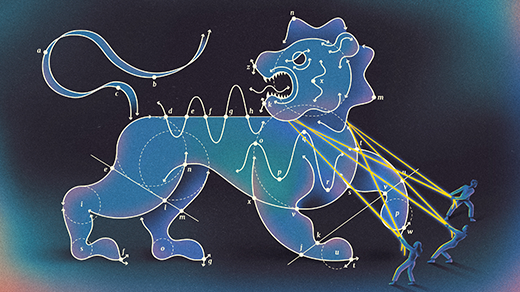Emmy Murphy Is a Mathematician Who Finds Beauty in Flexibility
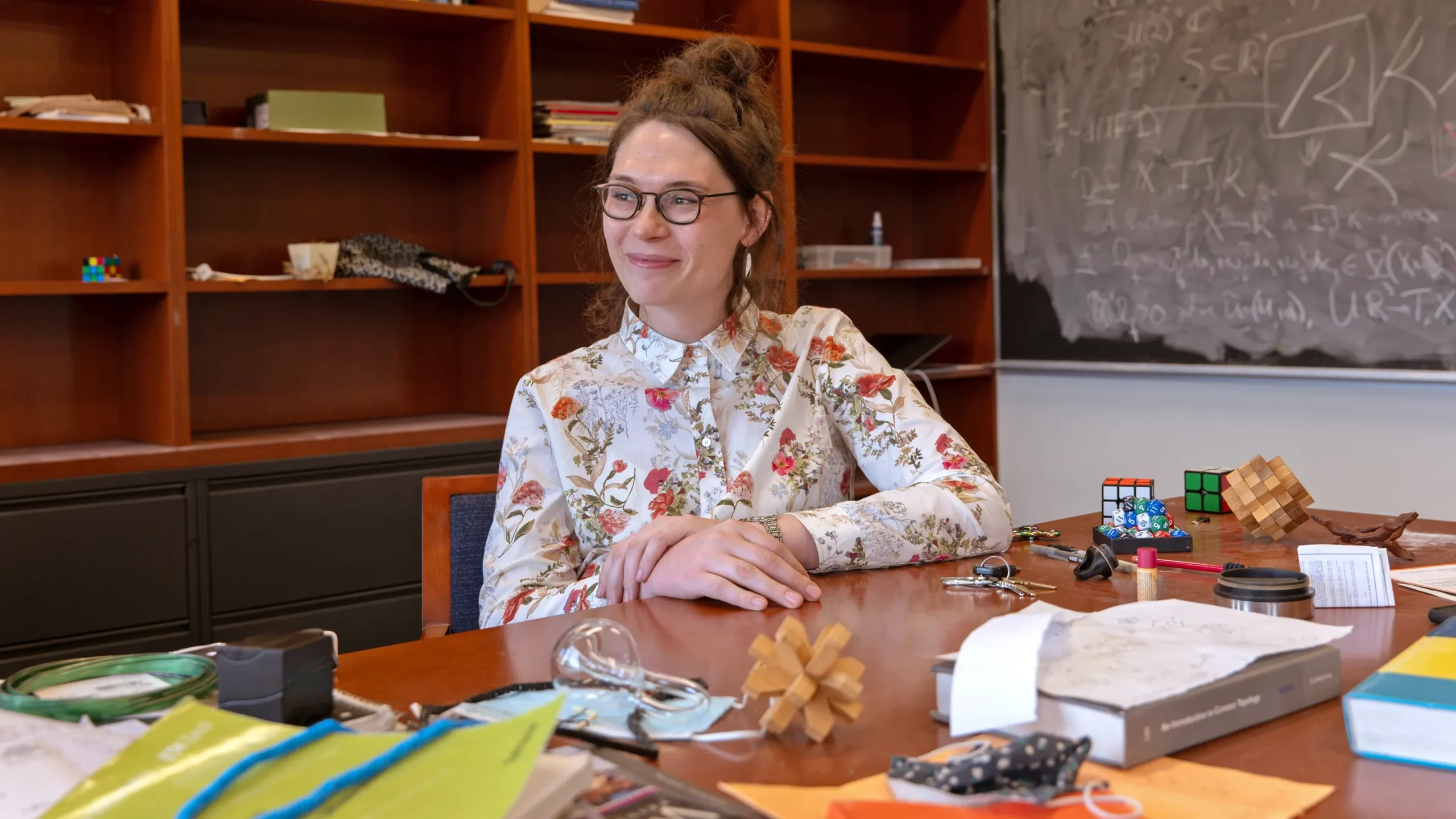
Emmy Murphy in her Princeton University office last month. “By the end of high school, I knew mathematics was what really tickled me,” she told Quanta.
Caroline Gutman for Quanta Magazine
Introduction
“For me, mathematics exists in the space between us,” Emmy Murphy wrote in accepting the 2020 New Horizons in Mathematics Prize.
That space, for her, is a realm of art, perhaps even more than science. And like an artist, she is most fulfilled when exploring the fertile ground where constraint meets creation. The objects she studies are “beautiful to me in the same way that architecture or fashion or expensive furniture is beautiful — the way they are both highly constrained by their geometry and also highly flexible,” she told Quanta.
Hailed as a highly original thinker, Murphy has uncovered “a startling degree of flexibility in a branch of geometry that is ordinarily distinguished by rigidity,” according to the citation for the 2017 Birman Research Prize.
The “space between us,” for Murphy, is not just a domain of abstract beauty, but also a meeting place of human minds. It’s no accident that she found her way into the dynamic and multidisciplinary field of symplectic geometry. “A big part of why I love the type of math I do is the opportunity to discuss it and share that beauty with others,” she said.
Murphy brings a unique vantage point not just to mathematics but also to the mathematical community. On paper, all that’s visible is a mathematician at the top of her profession: A full professor at Princeton University, Murphy delivered an invited lecture at the 2018 International Congress of Mathematicians and has won multiple prizes.
Yet Murphy’s path into mathematics research was anything but foreordained. The daughter of a nurse and an industrial valve salesperson, she was the first in her family to go to college. And she seriously weighed leaving academia after deciding, midway through graduate school, to come out as transgender.
Quanta spoke with Murphy about geometric spaces and the spaces inhabited by mathematicians. The interview has been condensed and edited for clarity.
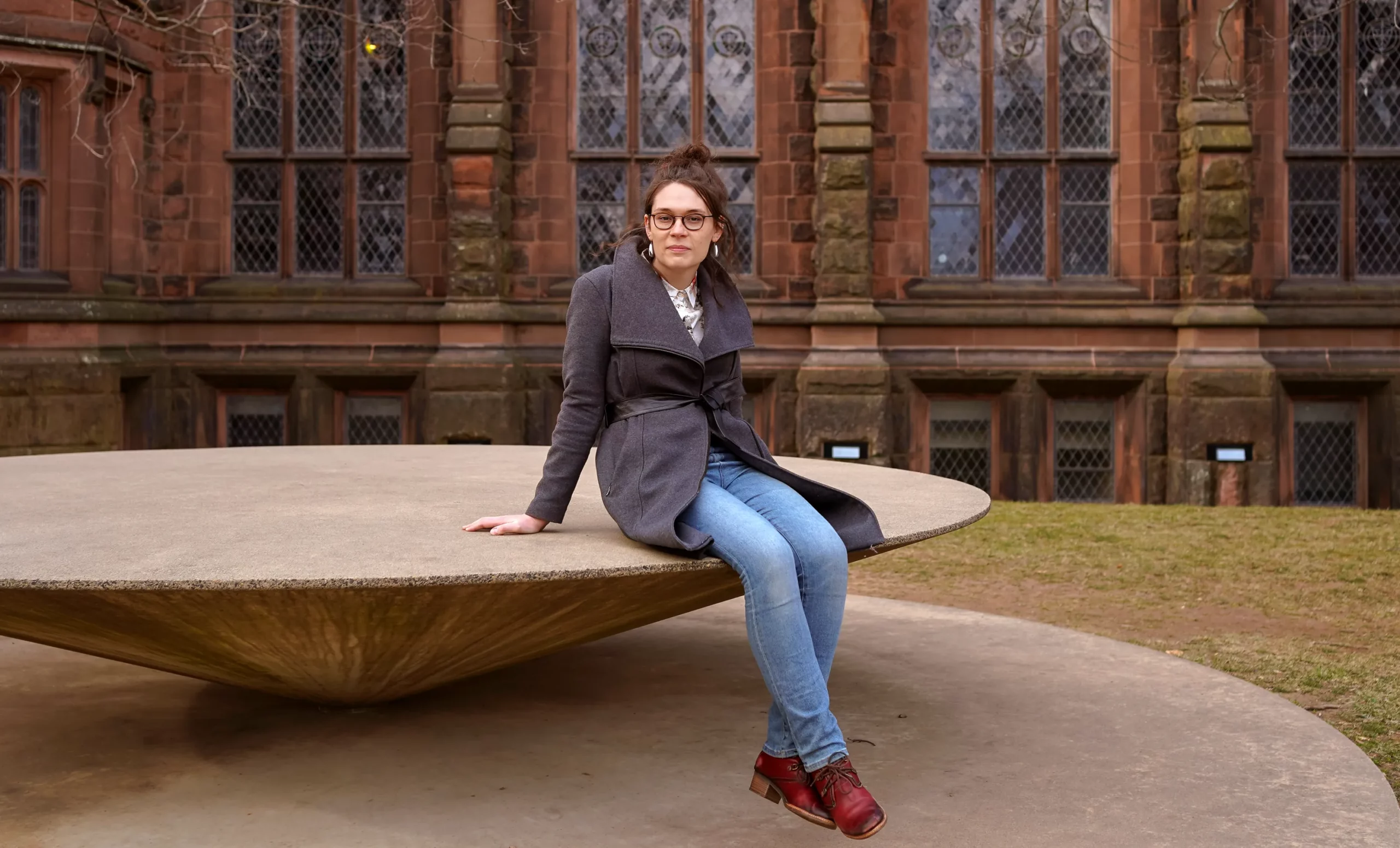
Murphy on the Princeton campus.
Caroline Gutman for Quanta Magazine
Did it feel like a given that you would go to college?
It felt kind of given, in that I always did well in school. And my parents were very supportive. It happened that in Nevada, they created a program called the Millennium scholarship, so students who went to Nevada high schools and then Nevada colleges would get a large portion of their tuition covered. So that made it easy. But the majority of my high school friends didn’t go to college.
By the end of high school, I knew mathematics was what really tickled me. So I was very much looking forward to a place where instead of having one calculus class, I could take four math classes. I didn’t have any picture in terms of a career. I knew I enjoyed learning math in the moment, so I went to college because I could continue learning it.
Did you feel like you fit in at college, as the first person in your family to go there?
I was a commuter student for the first half of college, and then the second half I just had an apartment. So I never had that college dorm experience. And most of my social life was spent with this group of friends I had through high school.
I think the much larger cultural adjustment, which was pretty difficult at the time, was starting grad school at Stanford, because UNR [University of Nevada, Reno] and Stanford are such different worlds. Stanford was an exposure to that world of generations of professors — my classmates whose father is a professor and whose grandfather was a professor. I didn’t feel like there was ever any hostility directed at me; it was just a foreign environment.
That’s when you started working in symplectic and contact geometry. What drew you to that field?
You can think of the different fields of geometry as existing along a spectrum from the most rigid to the most flexible. And what really attracted me to symplectic and contact geometry is that it is somewhere in the middle. I find that middle intriguing, because it’s very mysterious. And it’s also where a lot of the most visual geometry happens. When you go to a totally flexible world, it’s hard to explain why, but everything becomes algebra in a sense. And when you go into an extremely rigid world, so much depends on precise measurements. Whereas in between, visual thinking is more useful.
Something else I like is that it’s a very young field. Symplectic geometry has only been seriously studied for maybe 35 years, so people don’t know what’s going on all that well. Because of that, it brings in all these other fields and throws them in a mixing pot. And that makes it compelling.
What kind of structures does symplectic geometry deal with?
The roots are in classical mechanics. And one of the most important aspects of classical mechanics is that if I have some system, maybe a pendulum or the motion of the planets, then as long as I understand the energy for all possible configurations, I can deduce how that system evolves with time.
If we abstract that into a geometric structure, energy is just a function from the space to the real numbers, whereas the time evolution is a symmetry of the space. Classical mechanics gives you a way that, for any energy function, you get a symmetry. But if I have some random geometric space, it’s not clear how to do that. A symplectic structure is the ingredient which allows you to make that translation.
So is it about constructing worlds in which classical mechanics is allowed to behave differently from what we’re used to?
Yeah, it’s abstracting into a very foreign world. One way in which symplectic geometry is more general is, it works over any notion of energy.
With Einstein and relativity, a big insight is that space and time don’t really exist as separate entities so much as there’s this one thing called the space-time continuum. In classical mechanics, you see something similar, in that the equations can’t tell the difference between position and momentum. So when we’re building these abstract symplectic manifolds, a lot of these spaces don’t have separate notions of what position and momentum are.
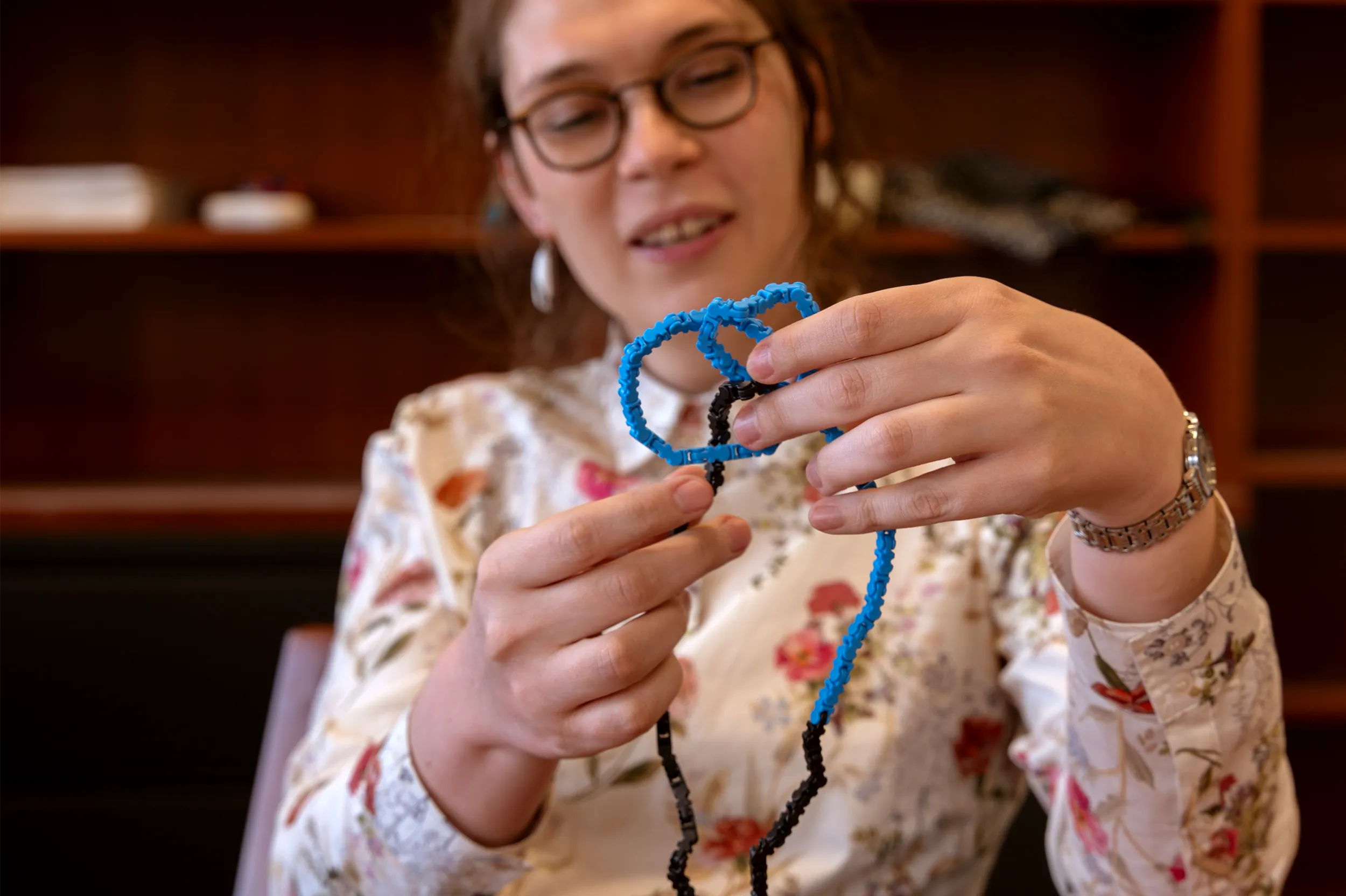
Murphy with a Legendrian knot, a mathematical object studied in her area of geometry.
Caroline Gutman for Quanta Magazine
Tell me about the “startling degree of flexibility” you’ve discovered in these shapes.
As an analogy, imagine a bicycle chain. It’s like a rope, except it’s easy to bend in one direction but not the other. If you tie it into a knot, you [might] want to ask, is it possible to untie this knot?
One thing you could do is say, “Let’s forget it’s a bicycle chain and pretend it’s rope.” Now, if you can’t untie it when it’s made of rope, you certainly can’t untie the bicycle chain, because that’s only going to be more difficult. But if it is possible to untie when it’s made of rope, it still might be impossible to untie the bicycle chain, because maybe you need to take some thin end and push it through itself, and it twists up too much and gets stuck because it’s too rigid.
In symplectic geometry, we can start with a geometric question, like, maybe we have some object inside a symplectic manifold and we want to ask if it’s possible to untie it. One thing we can do is forget the symplectic geometry and think about this as a smooth space. And it’s useful to think about how different the answers to these two questions are. Is the complexity of symplectic manifolds mostly just coming from the complexity of these more flexible, smooth spaces? Or can you do way more things in smooth spaces than in the symplectic setting? In general, it’s not clear what the answer is.
A lot of my most significant results have been in the flexibility direction, showing that as long as it’s possible to do something smoothly, it is also possible in the symplectic world.
Why did mathematicians find this flexibility so surprising?
Starting in 1983, there was the very first detection of rigidity in symplectic geometry — intricacies and obstructions you wouldn’t see in a purely smooth, flexible world. Then in 1985, there was the most significant result in symplectic geometry ever — the idea of pseudoholomorphic curves, due to Mikhael Gromov, which set out a machine for detecting and measuring these rigidities. Most of what drove the field forward until today was building up that machinery. There weren’t many people thinking in the opposite direction: Are there situations where these things are more flexible than we might expect?
When you wrote that “mathematics exists in the space between us,” what did you mean?
I love thinking about math as a social phenomenon. In every field, there are things that are considered important or influential. It’s very much fashion-based — a field becomes popular because certain people are working on it, or it happens to be moving quickly, or it connects to other things. The structure of what people choose to research is built out of aesthetic judgments.
And also, I enjoy math the most when I’m doing it with other people, standing in front of a blackboard with one or two mathematicians, and we’re just discussing, “Oh, is this true?” So when I say math exists in the space between us, I think of that as being true both on the largest and the smallest scales of mathematics.
I think a lot of people would say that even if nobody else was interested in what they study, they would happily continue studying it. But that’s not me at all.
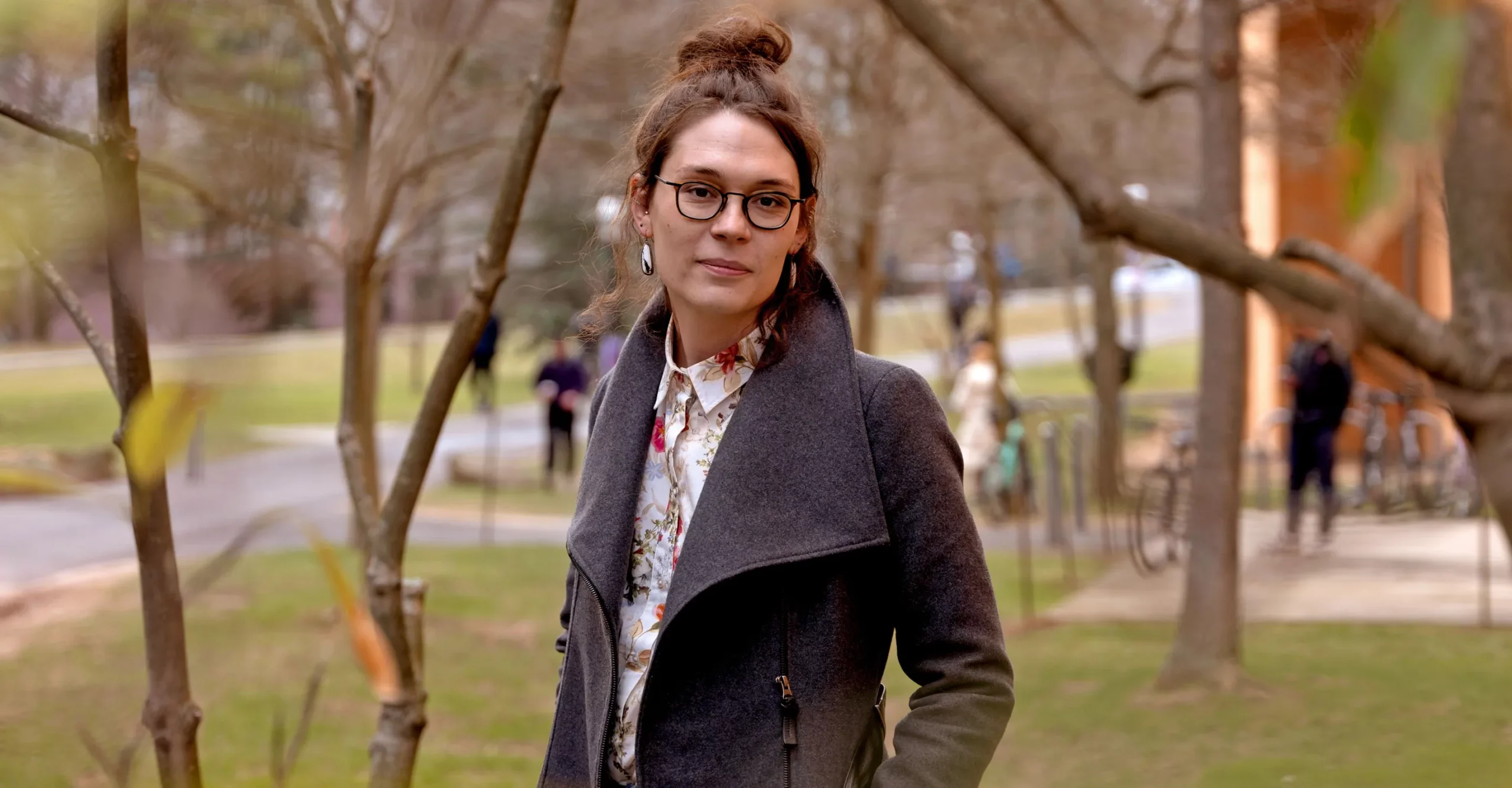
Caroline Gutman for Quanta Magazine
How does your math timeline intersect with your history as a trans person?
I transitioned at the tail end of grad school. When I was coming out, I didn’t know of any other trans people in math. I remember I found one article by this trans guy who wrote a short account of his experiences. But he left academia many years before I even entered grad school.
I felt very alone. In fact, I was confident that I was not going to stay in math, not because of explicit discrimination so much as just the expectation that when you come out, you start a new career where nobody knows you — this was more of a typical expectation back then. But it was also the lack of role models. If there’s no trans people in math then it’s easy to say, “OK, well, if I’m trans, I should leave math.”
This has changed a lot in recent years. Now, I know probably between 10 and 20 trans mathematicians, which is wonderful. I’m one of the older trans people in math that I know, and I feel some motherly love toward this community.
What made you decide to stay in academia?
When I first came out socially, I was not sure what I wanted to do for my dissertation. But then I landed on a specific thesis, and it was a good thesis, the sort of thing where it would be easy to find a job after graduating. So that was a big part of it.
And then, after you come out and live as a trans person, things which seemed very scary and intimidating, eventually you’re going to get used to them. So after being out in my personal life for a year, it was just, “Well, OK, I’ll come out [in my professional world] and see what happens.”
You’ve lived in the mathematical community first being seen as a man and then as a woman. How different have those two experiences felt?
I feel like I face more discrimination for being a woman than specifically for being trans. I don’t think there are many transphobic people in math, but what is common is that people will talk over you because you’re a woman. That’s a subconscious thing, the typical way sexism functions. I can certainly vouch that oftentimes as a woman, you are treated with less respect by other mathematicians.
Math tends to be heavily associated with maleness, and it can be a challenge for women mathematicians to navigate things like how people will perceive their femininity. How did that issue intersect with the challenges of coming out as a trans woman?
I feel like it was almost easier for me, in that by the time I was seen as a woman I had already established myself as a mathematician who was doing some level of good work. I didn’t need to prove myself in the same way most young women need to. And that ties in closely to these things you mentioned about gender presentation, and that if you present as too feminine, people will take you less seriously. I’m grateful that I didn’t have to deal with sexism when I was the most unestablished.
When you came out, you chose the name Emmy, which instantly rings bells for mathematicians because of the famous early 20th-century algebraist Emmy Noether. Did you have her in mind?
So, yes, it is because of Emmy Noether. But at the time I chose the name, I was planning to leave math. I was thinking about it as something that’s a reminder of what this previous life gave to me. She’s an inspirational figure, but a pretty obscure touchstone if you’re not in mathematics. If I’d known that I was going to stay as a mathematician, I certainly would not have done that, because it’s pretty big shoes to fill.
If you had followed through on your plan to leave math, what else could you imagine yourself doing?
I could see doing something in the design world — say, fashion or architecture. It informs a lot of how I think about math — it’s all about knowing, what’s the right curve or the right shape for the right situation? But I have no idea what the actual day-to-day reality of this sort of career is like.

